new posts in all blogs
Viewing: Blog Posts Tagged with: Respect, Most Recent at Top [Help]
Results 1 - 25 of 88
How to use this Page
You are viewing the most recent posts tagged with the words: Respect in the JacketFlap blog reader. What is a tag? Think of a tag as a keyword or category label. Tags can both help you find posts on JacketFlap.com as well as provide an easy way for you to "remember" and classify posts for later recall. Try adding a tag yourself by clicking "Add a tag" below a post's header. Scroll down through the list of Recent Posts in the left column and click on a post title that sounds interesting. You can view all posts from a specific blog by clicking the Blog name in the right column, or you can click a 'More Posts from this Blog' link in any individual post.
Hi, folks, this month I'm focusing the blog on the writing journey of PLUMB CRAZY. I'm calling this series: PLUMB CRAZY Journey -- The Good, The Bad, The Ugly and The Transcendent. I'm going to dig deep into the generation of my novel and dynamics of that creative journey. Be aware that I write as Cece Barlow for this work. It will be released at the end of this month.
This week I'm focusing on the the bad. That right! THE BAD! Every third person you meet ( not a scientifically proven fact but a personal observation) wants to write a novel. They also want to spend between fifteen minutes to an hour explaining that novel to you at every event you attend. Then they may suggest that you write it for them, for free of course, since you are a writer and basically have nothing to do. Writing a novel comes with the bad bonus that very few people respect your work. Anyone can write a book. If you are a children's writer, you work for peanuts, and that's if your lucky. Don't expect applause.
Writing a novel is no fun. Bad, bad, stuff. You sit in a chair. My sciatica is terrible. You stare at a blank page, then you write entire chapters that are totally worthless. The next day you repeat this experience. For me, I will repeat this experience 5 days a week for at least 8 months to reach Draft Number One! That draft has more holes than pumice. There will be many many drafts. I work hard. I spend months refining my work. Hours at critique group, hours reading support books, hours rewriting scenes and upping the stakes in anyway I can. There is monotony in this work. No one tells you when you are done. No one tells you when you should just drop this novel and work on something else. There is no way to know if anyone will ever read what you writing. And yet you write anyway.
I don't write novels in a vacuum. Novels are written in the real world. It can be very bad. I wish it were all about drinking cups of tea. I wish it were all about sitting in a beautiful spot and considering my imaginary world. It is not about that. It is about writing in a corner of a hospital waiting room. It's in the middle of a day job that is about a mindless as it gets. It's not just exterior stuff that will get you down. It's about writing yourself into a corner that there is no way out of and you have to scrap the whole draft and work on something else. It't about receiving tons of rejections and still pushing forward. It's about hoping against hope. No easy road, folks..
I hope that you are kind to yourself this week. I get it. We all are facing battles. No work comes easy to any of us. We have to pour our our souls sometimes to find our way.
I hope this doodle makes you smile. Yes, good work comes out of a lovely blobby brown mess.

By:
KidLitReviews,
on 3/9/2015
Blog:
Kid Lit Reviews
(
Login to Add to MyJacketFlap)
JacketFlap tags:
Children's Books,
compassion,
respect,
Picture Book,
death,
life cycle,
Owlkids Books,
5stars,
Library Donated Books,
Bárður Oskarsson,
picture books for older kids and adults,
unfathomable questions,
Add a tag

The Flat Rabbit
Bárður Oskarsson
Owlkids Books 9/15/2014
978-1-77147-059-9
40 pages Age 4+
x
“What do you do with a flat rabbit? A dog and a rat come across a rabbit. A flat rabbit, lying silently on the road. It all seems rather sad, so they decide to move her. But where to? They can’t just return her to her apartment, completely flattened. What would the neighbors think? The dog and the rat try to figure out what to do. Then the dog gets a brilliant idea. They decide to give the rabbit the send-off she deserves.”

Review
The Flat Rabbit deals with a serious subject most young child, under age 6, are incapable of understanding: the finality of death. The author uses humor in this gentle story of two friends sending off another friend—the flat rabbit—in a respectful manner, honorable and pleasing to the rabbit. They find their friend in the middle of the road and decide it cannot be much fun lying there. The dog and rat decide to help the rabbit move to a better place.
“Do you think she is having a good time? the rat finally asked . . .
“I don’t know . . .” he [the dog] replied slowly. “I don’t know.”
As a social worker, The Flat Rabbit would be a great tool for helping kids process not only death, but also separation. Nearly every page can provoke discussion. The abrupt ending demands discussion. The Flat Rabbit can open up discussions on the mysteries of life, the finality of death, and the use of compassion and respect.
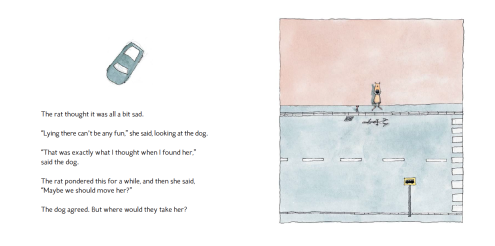
I also love the simple illustrations and the gentle humor.
“Do you know her?” [The rat asked the dog.]
“Well,” said the dog, “I think she’s from number 34. I’ve never talked to her, but I peed on the gate a couple of times, so we’ve definitely met.”
The Flat Rabbit may not be a typical picture book, but it does a great service for children dealing with, or asking about, death. Parents will have a platform for discussion and a gentle way to help their child cope with a difficult subject. The most important aspect, as this social worker sees it, is the respect and compassion for life and death that the author deftly deals with in The Flat Rabbit. The dog, after brainstorming most of the day, comes up with a brilliant plan to help the rabbit. The dog and the rat gently lift the rabbit off the road then spend the rest of the day and night on their plan to honor and care for the rabbit.
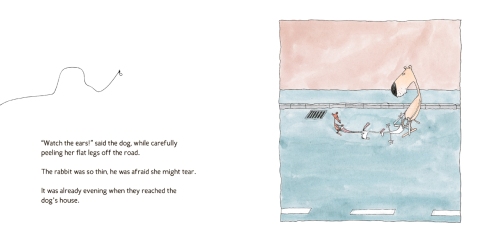
An interesting side note: the author lives in the Faroe Islands, an archipelago made up of 18 islands between Iceland and Norway. Flata Kaninin, the original version, was nominated for The Nordic Council Children and Young People’s Literature Prize 2014. Sadly, it did not win.
THE FLAT RABBIT. Text and illustrations copyright © 2011 by Bárður Oskarsson. Translation copyright © 2014 by Marita Thomsen. Reproduced by permission of the publisher, Owlkids Books Inc., Berkeley CA and Toronto, CAN.
X
Learn more about The Flat Rabbit* HERE.
Purchase The Flat Rabbit at Amazon —B&N—Book Depository—Owlkids Books
—B&N—Book Depository—Owlkids Books
x
Meet the author/illustrator, Bárður Oskarsson: short bio
Meet the translator, Marita Thomsen, at her website:
Find other wonderful picture books at the Owlkids Books website: owlkidsbooks.com
*The Flat Rabbit—original title Flata Kaninin—published in 2011 by BFL: www.bfl.fo
X

X
Copyright © 2015 by Sue Morris/Kid Lit Reviews
Filed under:
5stars,
Children's Books,
Library Donated Books,
Picture Book Tagged:
Bárður Oskarsson,
compassion,
death,
life cycle,
Owlkids Books,
picture books for older kids and adults,
respect,
unfathomable questions 







By:
Sue Morris,
on 9/15/2014
Blog:
Kid Lit Reviews
(
Login to Add to MyJacketFlap)
JacketFlap tags:
Children's Books,
respect,
Picture Book,
acceptance,
picture books,
Favorites,
children's book reviews,
friendships,
Peachtree Publishers,
Alex Latimer,
5stars,
differences in people,
Pig and Small,
size doesn't matter,
Add a tag
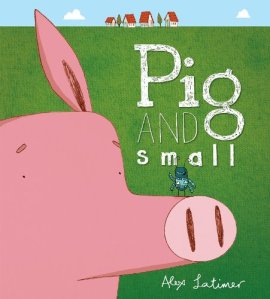 x
x
x
Pig and Small
Written & Illustrated by Alex Latimer
Peachtree Publishers 9/01/2104
978-1-56145-797-7
Age 4 to 8 32 pages
x
x
“Pig and Bug just want to be friends, but their size differences are proving to be a BIG problem. Pig wants to play games—but Bug is too small to keep up. Bug wants to make things for his friend—but Pig is too big to appreciate the craftsmanship! Just as they’ve given up all hope for a friendship, Pig has an idea. Will it work? (Yes, it will.)”
Opening
“Before this morning, Pig’s nose had never squeaked—not even once.”
Review
Poor Pig. His nose squeaked so much he even looked it up in a medical book. Squeaky Nose Syndrome is right after Squeaky Mouth Syndrome and before Squeaky Pants Syndrome. Wait, it isn’t there. There is no Squeaky Nose Syndrome. Pig examines his nose himself and finds the problem, which is not a problem at all, but a tiny bug. Bug is waving his arms—all four of them—trying to get Pig’s attention. Bug wants to be friends.
“Hello,” said Pig.
“Squeak, squeak,” replied Bug.
Pig and Bug start doing things together, but their friendship has problems from the start. What Pig likes to do—play board games, ride bikes, catch—was difficult and sometimes a wee bit dangerous for Bug, and what Bug likes to do—make things for Pig, Hide-N-Seek—was too small or too hard for Pig. They decide to part ways.
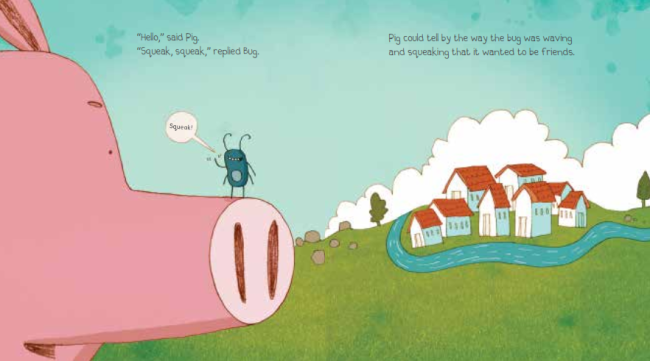
I really like the illustrations by Alex Latimer. He also wrote and illustrated Lion vs. Rabbit (reviewed here), The Boy Who Cried Ninja (reviewed here), and Penguin’s Hidden Talent (sadly, not reviewed here). I love the simple lines and colorful characters that always shine with emotions. He also adds small details that I love and often find amusing. Latimer’s picture books use humor and situations to teach young children without seeming to send a message. In Pig and Small, size makes a difference for BIG Pig and small Bug, so they decide not to be friends. However, this is not the end of Pig and Small.
Pig turns to leave, after he and Bug decided to go their own ways, and the wind, blowing mighty hard, whips a newspaper at Pig, sticking it to his face. Open to the movie section—The Pirate, the Ninja, and the Invisible Dog—Pig realizes there are many things he and Bug can both enjoy. They go see the movie and have a great time. Bug . . . nah, I’ll leave the details between the pages. Do not miss the BIG finale.
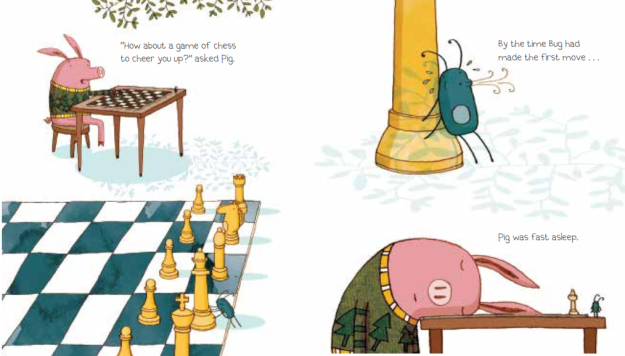
BIG Pig and small Bug decide size does not matter. There are many things the two interesting friends can do together that both enjoy. They enjoyed the movie and talk about it on the way home. There are museums, zoos, plays, and aquariums awaiting them. Size does not matter in friendships. Differences melt away between friends and they find ways to enjoy their time together.
Once again, Latimer’s soft, easy tones guide us to a new understanding of what friendship is about, or rather what it is not about—size. With kids back in school and the holidays approaching (much too fast), children have the opportunity to make many new friends. After reading Pig and Small, they will understand that size does not matter in friendship, or do friends need to have identical likes to get along and be friends. Friendship, as in life, is a compromise and differences should not matter . . . at least not to friends like Pig and Bug.
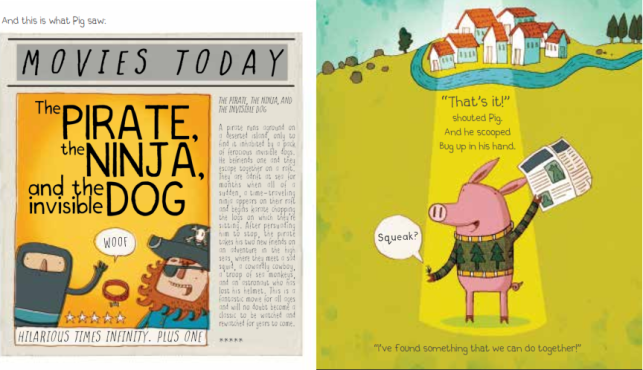
PIG AND SMALL. Text and illustrations copyright © 2014 by Alex Latimer. Reproduced by permission of the publisher, Peachtree Publishers, Atlanta, GA.
x
Pick up Pig and Small at Amazon —B&N—Book Depository—Peachtree Publishers—your favorite local bookstore.
—B&N—Book Depository—Peachtree Publishers—your favorite local bookstore.
x
Learn more about Pig and Small HERE
WIN PIG AND SMALL from Peachtree Publishers HERE
Meet the author and illustrator, Alex Latimer, at his website: http://www.alexlatimer.co.za/
Check out what he has to say at his blog: http://alexlatimer.blogspot.com/
Tweet him at his Twitter: https://twitter.com/almaxla
Find excellent picture books at the Peachtree Publisher’s website: http://peachtree-online.com/
Peachtree has a blog with occasional giveaways here: http://peachtreepub.blogspot.com/
Also by Alex Latimer
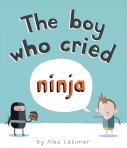
The Boy Who Cried Ninja
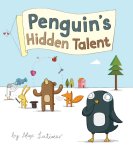
Penguin’s Hidden Talent

Lion vs Rabbit
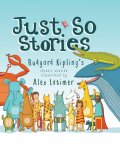
Just So Stories

The Space Race

The South-African Alphabet
x
x
x
x
x
x
x
x
x

x
Copyright © 2014 by Sue Morris/Kid Lit Reviews
Filed under:
5stars,
Children's Books,
Favorites,
Picture Book Tagged:
acceptance,
Alex Latimer,
children's book reviews,
differences in people,
friendships,
Peachtree Publishers,
picture books,
Pig and Small,
respect,
size doesn't matter 







By:
Sue Morris,
on 9/3/2014
Blog:
Kid Lit Reviews
(
Login to Add to MyJacketFlap)
JacketFlap tags:
Children's Books,
respect,
Picture Book,
imagination,
relationships,
pets,
picture books,
cats,
dogs,
children's book reviews,
Debut Author,
4stars,
Library Donated Books,
Debut Illustrator,
be kind to pets,
Gregory E. Bray,
Holly J. Bray-Cook,
Add a tag
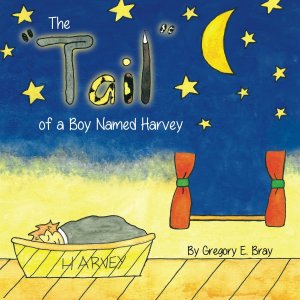 x
x
x
The “Tail” of a Boy Named Harvey
Written by Gregory E. Bray
Illustrated by Holly J. Bray-Cook
Published by Gregory E. Bray 6/01/2013
978-1-488271465-4
Age 4 to 8 32 pages
x
x
“Harvey is always playing with his pets, but his pets don’t like the way he plays with them. When the tables have turned, will he enjoy the way he’s played with?”
Opening
“Harvey was an energetic boy. He loved playing sports.”
The Story
Harvey is a typical five-year-old. He is rambunctious, energetic, imaginative, and self-centered. Harvey loves playing with his pets: a dog and a cat (names not given). Being a young boy, he does not think of either pet’s feelings or consider how they might like to play. The pets are like large dolls that breathe. Harvey puts clothes on them, uses the cat as a basketball, and dresses both up in military garb when he wants to play army—sending the cat up into the air so it may return in a parachute. To say Harvey plays rough with his companions is a mild way of describing his actions. Harvey plays like a little boy plays, with energy and enthusiasm.
The poor dog and cat are not happy and try to avoid Harvey at all costs. His parents cannot figure out why the pets react so adversely to their son, until the day mom catches Harvey ready to catch his parachuting kitty.
“She sent him to his room after dinner and he was only allowed to come out for school and meals.”
Harvey’s response to his punishment further shows he has no idea what he did to get into so much trouble.
“Stupid pets!” [Harvey said, while lying in bed.]
Review
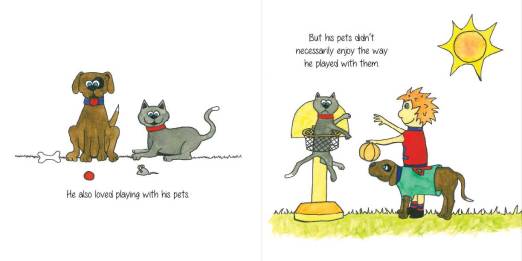
I really like The Tail of a Boy Named Harvey. Subconsciously, Harvey understood what he did was wrong. In his dream, he is the “pet” and the pets “own” him. The pets play with Harvey exactly as he played with them—thrown up in the air, dressed up, and abruptly awakened. Harvey hates this “playing.” The army games the pets play with Harvey terrify him enough to jolt him awake. Mom tells him it is only a dream, but Harvey has other thoughts on his mind,
“I’m sorry guys. I didn’t know how bad I treated you. I promise to play nice with you for now on!”
I like The Tail of a Boy Named Harvey because animal abuse starts with that first inappropriate action. While most kids do not continue on abusing animals—and later extend the abuse to humans—the sooner they learn to respect their pets, the faster they will learn to respect other people and themselves. Harvey’s self-centeredness, typical for his age, opened up a notch with his revelation. I love that Harvey came to this realization mainly by himself, though he would have gotten there much slower had mom not punished him. This is a perfect example of how kids learn. The author’s inspiration for the book came in part from his son Liam and their cat Harvey. The author got it right.
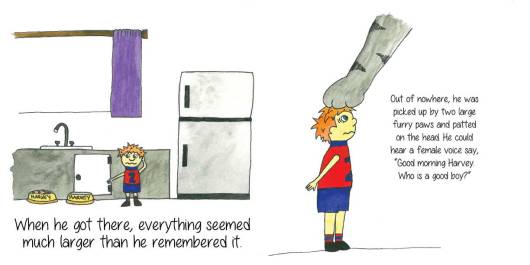
Now, what I do not like about The Tail of a Boy Named Harvey. I am not a fan of the 8 x 8 format mainly because little hands need the stronger pages of a traditional picture book format. A couple of pages came loose from the binding in my copy. The main problem with the story is the lack of action. The narrator tells us 90 percent or more of what is happening instead of letting the characters do this. The story would be more engaging had this happened. The reader would also be able to add to the story by adopting character voices and further charm their child. Please remember the key maxim: Show not Tell.
The illustrations are good, not traditional looking picture book illustrations, but nicely done. The pets are great at showing their dislike through facial expressions, though my cat would have simply hissed or bit, then run away. When the pets do run away, their fast retreat is nicely illustrated. The illustrator made sure we understood Harvey’s point of view drastically changes when he becomes the pet. The dog and cat (wish they had names) are adorable. Nice job with the little details I love so much.
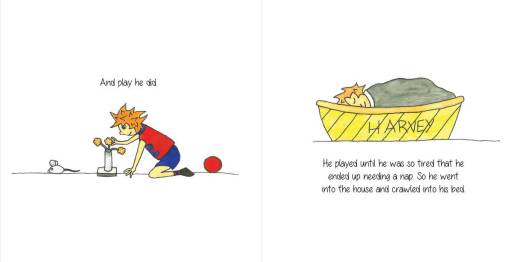
I think kids will like The Tail of a Boy Named Harvey. Young kids will appreciate the story and laugh at Harvey’s predicament. Those with pets will quickly learn from Harvey and that is a great thing to happen. Classrooms with a pet would do well to read this story, as would any child soon to get their first pet. The Tail of a Boy Named Harvey is the author’s, and the illustrator’s, first children’s book. They both did a nice job bringing the story of Harvey (the cat or the boy, I am no longer sure which) to life.
THE TAIL OF A BOY NAMED HARVEY. Text copyright © 2013 by Gregory E. Bray. Illustrations copyright © 2013 by Holly J. Bray-Cook. Reproduced by permission of the publisher, Gregory E. Bray, Sacramento, CA.
For a young lad’s critique, click HERE
x
Purchase The Tail of a Boy Named Harvey at Amazon —B&N—CreateSpace—Gregory Bray—your favorite bookstore.
—B&N—CreateSpace—Gregory Bray—your favorite bookstore.
Learn more about The Tail of a Boy Named Harvey HERE
Meet the author, Gregory E. Bray, at his blog: http://gregoryebrayauthor.blogspot.com/
Meet the illustrator, Holly J. Bray-Cook, at her website:
Gregory E. Bray published through CreateSpace Independent Publishing Platform
x

Copyright © 2014 by Sue Morris/Kid Lit Reviews
x
A Little about Gregory E. Bray
 x
x
“Gregory E Bray (1967-present) was born and raised in Sacramento, CA where he still resides He was a film major in college who now works in the IT industry. He has written scripts for corporate videos and shorts and uses humor in everything he writes. He uses his humor in this, his first children’s book, to help get the books message out to children. His inspiration for writing this children’s book comes from his wife Lita, their son Liam and their cat Harvey.”
How to Find Gregory E. Bray
Website:
Blog: http://gregoryebrayauthor.blogspot.com/
Facebook: https://www.facebook.com/gregoryebray
Goodreads Author Page: https://www.goodreads.com/geb1967
Amazon Author’s Page: amazon.com/author/gregorybray
Filed under:
4stars,
Children's Books,
Debut Author,
Debut Illustrator,
Library Donated Books,
Picture Book Tagged:
be kind to pets,
cats,
children's book reviews,
dogs,
Gregory E. Bray,
Holly J. Bray-Cook,
imagination,
pets,
picture books,
relationships,
respect 







By:
Bianca Schulze,
on 7/4/2014
Blog:
The Children's Book Review
(
Login to Add to MyJacketFlap)
JacketFlap tags:
Pirates,
Ages 4-8,
Respect,
Bullying,
Friendship,
Picture Books,
Author Showcase,
Social Graces,
Carole P. Roman,
Captain No Beard,
Add a tag
Just like all of the Captain No Beard stories, The Crew Goes Coconuts is super kid-‐ friendly with bright illustrations. It contains all of the familiar and favorite characters of books past, plus the introduction of Matie the goat, and fans of the series will enjoy boarding the Flying Dragon once again with all of their old friends.

By: Elizabeth Gorney,
on 7/3/2014
Blog:
OUPblog
(
Login to Add to MyJacketFlap)
JacketFlap tags:
Science & Medicine,
well being,
Psychology & Neuroscience,
Corporate Wellness Week,
Maureen Duffy,
Overcoming Mobbing,
mobbing,
Books,
respect,
safety,
communication,
structure,
abuse,
workplace,
empathy,
company,
*Featured,
Add a tag
By Maureen Duffy
What do we mean when talk about workplace health and well-being these days? How well are we doing in achieving it?
Traditionally, the notion of employee health and well-being was about protecting workers from hazards in the workplace and insuring physical safety. From this early focus on the physical safety and health of workers, the concept of workplace health evolved to include the protection and promotion of personal physical health and well-being. Corporate wellness programs emphasizing health promoting behaviors like smoking cessation, weight loss, exercise and nutrition, and management of chronic diseases like diabetes fall into this category.
More recently, the idea of employee health and well-being has evolved to include protection and promotion of the psychological safety of workers, the sustainability of the organization itself, and active participation in health promotion of the local community. The World Health Organization developed a definition of workplace health and well-being that includes all of these dimensions. Grounded in research, it defines a healthy workplace as: “one in which workers and managers collaborate to use a continual improvement process to protect and promote the health, safety and well-being of all workers and the sustainability of the workplace by considering the following, based on identified needs:
- health and safety concerns in the physical work environment;
- health, safety and well-being concerns in the psychosocial work environment, including organization of work and workplace culture;
- personal health resources in the workplace; and
- ways of participating in the community to improve the health of workers, their families and other members of the community.”
The World Health Organization’s is not the only definition of workplace health and well-being but it’s a good starting point for conversation.

“Who are clinical social workers?” ACSWA. Photo Courtesy of Maureen Duffy via iStockphoto.
Employee health and well-being, especially psychological and emotional health, could be faring a whole lot better than it is. To start with, the Gallup Organization, in its most recent worldwide survey of employee engagement found that only 29% of North American employees were engaged, and this low number represented the highest rate of engagement among all regions of the world surveyed. That leaves 70% of North American employees unmotivated and disconnected, to some degree or another, from their work and workplaces. Add to widespread lack of engagement the results of the 2014 Workplace Bullying Institute’s US workplace bullying survey indicating that 27% of Americans surveyed had personally experienced repeated mistreatment and abusive conduct at work and an additional 21% reported witnessing it. Especially from the perspective of psychological heath, well-being, and safety, the findings from these two recent surveys paint a gloomy picture and suggest that modern organizational life is in trouble.
A helpful way of improving psychological health, well-being, and safety in the workplace is through the implementation of guiding principles to make the organization more resistant to workplace bullying, mobbing, and abuse. These principles are values-driven, action-oriented, and structure-sensitive.
Guiding Principle #1: Place values like empathy, respect, and ethical communication at the center of organizational life.
- Empathy is the lens through which co-workers, customers and people served, and complex situations are viewed. What does this situation mean for this person or these people? What is it like to be this co-worker, this manager, this customer, this patient, this student, this teacher, in this situation, and what can this organization do to improve the experiences for each of them? Such deep empathy guides problem assessment and solution-building. The design and innovation company, IDEO is a wonderful example of a company that is built around the value of active empathy.
- Respect is the value that guides how we treat each other, acknowledge each other’s presence, and recognize each other’s contributions to fulfilling the organizational mission. Practicing respect also allows for embracing diversity and accepting differences. Some work futurists who want to embrace the power of diversity to push innovation and solution-building endorse moving away from consensus models toward dissensus models. In dissensus models, hidden, differing, or even critical perspectives about an organizational situation or challenge are actively sought and gathered. Dissensus models take outlier views into account, thereby including all viewpoints, thus avoiding some of the pitfalls of consensus-building and groupthink. While respect as a value is written into many organizational mission statements and codes of conduct, it is worth remembering what the cybernetician and organizational theorist, Stafford Beer, cautioned; namely, that a work system is what it does (not necessarily what it says it does). Whether respect is actually practiced as a value in an organization shows up in how people both talk about one another and act toward one another.
- Ethical communication brings together the values of empathy and respect and is the single most important way of aligning these values with behavior to reduce and prevent mobbing, bullying, and other forms of workplace abuse. Ethical communication offers a map for how to talk with others when they are present and how to talk about them when they are not. Ethical communication in the workplace excludes gossip, backstabbing, shunning and ostracizing, applying pejorative labels about the personalities or personal lives of others, and shutting people out of critical information loops necessary to do their jobs. Ethical communication includes transparency and openness among all organizational members irrespective of rank. The late Michael White, a renowned narrative therapist, adhered to a principle of ethical communication in conducting therapy that, if applied within organizations, would go a long way toward reducing workplace abuse, mobbing, and bullying. The principle that White rigorously adhered to was only talking about clients in their absence as he would in their presence—no matter who the third party was or how influential or powerful. Imagine how different and how much psychologically safer organizational life would be if everyone in the organization adopted Michael White’s principle of ethical communication!
Guiding Principle #2: Keep an action orientation toward the mission, tasks, goals, projects, and purpose of the organization.
In other words, this principle is about doing the work of the organization at full throttle every day. The work of the organization is not the perpetuation of the organization despite appearances to the contrary in a number of cases. The work of the organization is to provide goods and services that benefit and please end-users while inspiring those involved in their creation and production. Workers who are inspired, active, and involved are much more likely to work with each other rather than against each other as happens in workplace bullying, mobbing, and abuse.
Guiding Principle #3: Pay attention to structure sensitivity and how the organizational structure impacts the productivity of the organization and well-being of its personnel.
Suggesting that organizations pay attention to their own structures and modify or change them when they no longer seem to serve either the end-users or organizational members might seem like a tall order. But it’s a tall order that’s catching on. Zappos, an online shoe and clothing store with over 1,500 employees, is abandoning hierarchy, bosses, and management as we have come to know it in favor of a non-hierarchical, distributed system of power called Holacracy. Other companies are already using the Holacracy model and still others are utilizing structures that rely on networks and self-organizing systems rather than on bureaucracy and hierarchy. Traditional hierarchical organizational structures rely on outdated methods of control that are authoritarian in nature, even when benignly so, and emphasize obedience, conformity, and punishment. Caring for the psychological health and well-being of employees and, indeed all organizational members, may in the final analysis include serious attention to organizational structure and the possibility of structural change. Such structural sensitivity and change may also be required to rid our workplaces of bullying and mobbing and their destructive effects on the individual and the organization.
The news about organizational life and about emotional and psychological well-being within organizations is not good. Creating organizations that are more humane and that are inviting and exciting places to spend so much of our time is worth our biggest thinking and our willingness to dare to make them better.
Maureen Duffy is a consultant about workplace and school issues, including mobbing and bullying, a family therapist and educator and is the co-author of Overcoming Mobbing: A Recovery Guide for Workplace Aggression and Bullying and Mobbing: Causes, Consequences, and Solutions. Read her previous blog posts.
Subscribe to the OUPblog via email or RSS.
Subscribe to only psychology articles on the OUPblog via email or RSS.
The post Improve organizational well-being and prevent workplace abuse appeared first on OUPblog.

By:
Bianca Schulze,
on 3/20/2014
Blog:
The Children's Book Review
(
Login to Add to MyJacketFlap)
JacketFlap tags:
Respect,
Friendship,
Adventure,
Acceptance,
Picture Books,
Nature,
Butterflies,
Books for Boys,
Personalities,
Puppies,
Author Showcase,
Turtles,
Animal Books,
Social Graces,
Dedicated Reviews,
Kristin Carella,
Robin Robinson,
Add a tag
Ned is a book-smart turtle with a very introspective way of thinking. As Rosco cartwheels onto the scene singing a song, Ned’s long awaited moment of serenity is shattered and so begins the story’s true tale of accepting differences and finding a balance between learning and living.
The newest offering of the Defective Amish Detective is available now! You can get Vol 6: The Sausage Log Implosion on Kindle here: http://amz.to/11MckpP
I have to say this whole experience has been a lot of fun. When Giovanni approached me about this series, I was a little hesitant. I have always known him to have an outrageous sense of humor and I knew the Amish were handled with a great deal of respect. I did not know how we would blend the two.
What came out of it was a story with lots of heart and its own kind of zaniness. I think we manage to show the proper amount of respect to the Amish. Much of the slapstick falls on the Defective Detective, who is not Amish. What is he? Something of a repentant hitman. Both of our main characters have mysterious pasts that give them unique skills to handle the cozy mysteries we throw at them.
In the end, this series is about friendship and understanding. It is about two men coming from two different worlds and overcoming their differences to work together for the greater good. It is a pleasure to write and I hope you have as much fun reading it!
About The Sausage Log Implosion:
“Muck is Muck,” Eli the Blacksmith says.How does the Defective Detective go from having a near perfect day to one of the worst? Simple – someone stole his sausage log. Everyone has something in life that makes them happy. For G, it is the culinary delights of the Amish, including whoopie pies and sausage logs. When his favorite market is sold out, G wants to know why. The charming, but innocent, counter girl tells him that the butcher’s meat grinder has been stolen. When something goes awry in Amish Country, G can’t let it go. He joins his stalwart companion Eli and the two of them are on the case. They have two questions to answer. What happened to the meat grinder? And, how much muck is too much muck? This is one explosive implosion!
By:
KidLitReviews,
on 9/26/2012
Blog:
Kid Lit Reviews
(
Login to Add to MyJacketFlap)
JacketFlap tags:
Children's Books,
family,
courage,
respect,
relationships,
Middle Grade,
Favorites,
fear,
middle grade books,
lost and found,
authority figures,
5stars,
Library Donated Books,
fear of authorities,
Add a tag
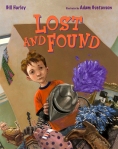 5 Stars
Lost and Found
Bill Harley
Peachtree Publishers
No. Pgs: 32 Ages: 4 - 8
.............
5 Stars
Lost and Found
Bill Harley
Peachtree Publishers
No. Pgs: 32 Ages: 4 - 8
.............
Peachtree Website: When Justin loses the special hat his grandmother made for him, he looks everywhere he can think of to find it. Everywhere, that is, except the lost and found. Mr. Rumkowsky, the old school custodian, is the keeper of all the lost and found items, and everyone is afraid of him, including Justin.
With his grandmother coming to visit soon, his mom upset, and the hat nowhere in sight, Justin finally musters the courage to enter Mr. Rumkowsky’s domain. There he discovers a whole world of treasures – lost items Justin’s friends (and generations of children before them) have been too afraid to claim. Things keep getting weirder and weirder, until way down at the bottom of Rumkowsky’s giant box Justin unearths something completely unexpected…
∞∞∞∞♦♦∞∞∞∞
Justin has lost his hat, the special hat, the one grandma made him, with the red ball on top that fell off. Now, grandma is coming for a visit and mom is upset that Justin has lost his hat. But Justin has asked all his friends and no one has seen his hat.
“Did you ask Mr. Rumkowsky?”
 None of the kids wanted to ask Mr. Rumkowsky if he found anything they had lost. They were each too afraid of Mr. Rumkowsky, who was the old custodian located at the end of the scary hallway, behind the cafeteria. Justin continued to look every place imaginable and a couple more after those. Finally, Justin knew what he had to do. His grandma was coming for a visit and he needs his hat.
None of the kids wanted to ask Mr. Rumkowsky if he found anything they had lost. They were each too afraid of Mr. Rumkowsky, who was the old custodian located at the end of the scary hallway, behind the cafeteria. Justin continued to look every place imaginable and a couple more after those. Finally, Justin knew what he had to do. His grandma was coming for a visit and he needs his hat.
Mr. Rumkowsky has been with the school forever and he grumbles and frowns. This makes him look scary and none of the kids wants to find out if they are wrong, because they believe they are right. Justin is at the end of his rope and must now go to the lost and found, which means going to see Mr. Rumkowsky.
I enjoyed Lost and Found. The basement corridor that went past the custodian’s office was terrifying in elementary school, as was the dreaded principal’s office. The authority these imposing adults had over “us” kids was actually terrifying. Like Justin and his friends, we were afraid though we had no real information to make such a decision. Unlike Justin, none of us was ever brave enough to go down that hall. Justin shows much courage not once, but twice and several times after that. Soon, Justin discovers treasures galore in the  lost and found from generations of students, and he finds Mr. Rumkowsky is a good guy.
lost and found from generations of students, and he finds Mr. Rumkowsky is a good guy.
The illustrations really set the mood for this story. The full spreads are wonderful representations. The custodian’s door has multiple locks that perpetuate this climate of fear. This generational mistrust is easily seen. A closer look at those locks on the custodian’s door shows they are on the inside of the door, as if Mr. Rumkowsky was afraid of what might enter, perhaps a student needing help finding a lost item.
Boys and girls will love Lost and Found, especially if they have a similarly scary person at their school. Librarians and teachers will love this book for its perfect story time quality, the expressive text matched with the dynamic illustrations, that can be seen to several rows back.. Mr. Harley and Mr. Gustavson have produced a picture book that is unique yet captures a common childhood dilemma: the fear of authority.
Interview with Author Bill Harley HERE!
Author: Bill Harley website activity fun! newsletter
Illustrator: Adam Gustavson website facebook
Publisher: Peachtree Publishers website
Release Date: October 1, 2012
ISBN: 978-1-56145-628-4
Number of Pages: 32
Ages: 4 to 8
Grades: Pre-K to 3
.............

Filed under:
5stars,
Children's Books,
Favorites,
Library Donated Books,
Middle Grade Tagged:
authority figures,
children's books,
courage,
family,
fear,
fear of authorities,
lost and found,
middle grade books,
relationships,
respect 






By:
Joe Sottile,
on 9/11/2011
Blog:
Joe Silly Sottile's Blog
(
Login to Add to MyJacketFlap)
JacketFlap tags:
grateful,
powerful words,
poetry for adults,
poetry blog,
a life that matters,
poetry blogsoetry blog,
respect,
man,
America,
grandparents,
grandkids,
Lord,
Add a tag
MEET ME IN THE STAIRWELL
PLEASE READ TO THE VERY END, IT IS BEAUTIFUL!!!'MEET ME IN THE STAIRWELL'
You say you will never forget where you were when
you heard the news On September 11, 2001.
Neither will I.
I was on the 110th floor in a smoke filled room
with a man who called his wife to say 'Good-Bye.' I
held his fingers steady as he dialed. I gave him the
peace to say, 'Honey, I am not going to make it, but it
is OK..I am ready to go.'
I was with his wife when he called as she fed
breakfast to their children. I held her up as she
tried to understand his words and as she realized
he wasn't coming home that night.
I was in the stairwell of the 23rd floor when a
woman cried out to Me for help. 'I have been
knocking on the door of your heart for 50 years!' I said.
'Of course I will show you the way home - only
believe in Me now.'
I was at the base of the building with the Priest
ministering to the injured and devastated souls.
I took him home to tend to his Flock in Heaven. He
heard my voice and answered.
I was on all four of those planes, in every seat,
with every prayer. I was with the crew as they
were overtaken. I was in the very hearts of the
believers there, comforting and assuring them that their
faith has saved them.
I was in Texas , Virginia , California , Michigan , Afghanistan .
I was standing next to you when you heard the terrible news.
Did you sense Me?
I want you to know that I saw every face. I knew
every name - though not all knew Me. Some met Me
for the first time on the 86th floor.
Some sought Me with their last breath.
Some couldn't hear Me calling to them through the
smoke and flames; 'Come to Me... this way... take
my hand.' Some chose, for the final time, to ignore Me.
But, I was there.
I did not place you in the Tower that day. You
may not know why, but I do. However, if you were
there in that explosive moment in time, would you have
reached for Me?
Sept. 11, 2001, was not the end of the journey
for you. But someday your journey will end. And I
will be there for you as well. Seek Me now while I may
be found. Then, at any moment, you know you are
'ready to go.'
I will be in the stairwell of your final moments.God
During the next 60 seconds, stop whatever you are
doing, and take this opportunity. (Literally it
is only 1 minute.) All you have to do is the
following:
Stop and think and appreciate God's power
By:
Joe Sottile,
on 2/22/2011
Blog:
Joe Silly Sottile's Blog
(
Login to Add to MyJacketFlap)
JacketFlap tags:
kids,
respect,
joy,
Rochester,
Gates,
back-pocket poetry,
saving the planet,
Democrat and Chronicle,
retired,
reaching kids,
a life that matters,
poetry shows,
Chili High School,
Add a tag
If you've ever been to the Rochester Children's Book Festival, you've likely seen Joe"Silly" Sottile (yes, it rhymes!) decked out in his rainbow-colored propeller hat. But the truth is, Sottile wears many hats.
Please click below for the rest of the story:
Ashley Bryan deserves a special valentine for bringing so much joy to the realm of

children’s
literature. From his witty, rhythmic retellings of folktales to his bold and beautiful paintings, woodcuts, and
collages, Bryan has enriched the lives of countless readers around the world. You can meet this beloved author/illustrator by opening
Ashley Bryan: Words to My Life’s Song (Atheneum, 2009)
. This
engaging autobiography shines with light, color, and love. Bryan, 87 and still thriving, invites us to hear his story, enlivened with his own poetic, accessible language and with a potpourri of photographs that reveal his childhood world, his family, his artwork, his Bronx neighborhood, his parents’ home back in Antigua, as well as his life on Little Cranberry Island. We get a sense of how he evolved as an artist; one touching painting shows him as a wide-eyed child, book in hand, staring out the window at night. Images of birds — which filled the family’s living room — and the echoes of his mother singing will show up, of course, in Bryan’s books, as shown in the illustrations reproduced in this book. Bryan’s childhood was punctuated by drawing, painting, reciting poetry, and listening to the Bible stories his mother read to him and his siblings. His recalls how they were the first black family to join the pretty St. John’s Evangelical Lutheran Church — where he would one day design a stained-glass window over the altar, showing a magnificent, dark and honey-hued image of Jesus rising from the tomb. After high school, he went, portfolio in hand, to a prominent art institute. A representative there told him his artwork was the best he had seen and that “it would be a waste to give a scholarship to a colored person.”
Bryan persevered. He was accepted at the Cooper Union School of Art and Engineering, and his world widened. After serving in WWII and graduating from Columbia, he taught art (from prep school to Dartmouth), and eventually made his way to the peak of children’s book illustrators. This autobiography does not brag about Bryan’s multiple awards; instead, it beams with his humble, respectful and indomitable creative spirit. It invites us all to reach inside and listen to that still, precious voice … and to celebrate life while you can.
Of Ashley Bryan’s nearly three dozen books, which do you like best? One of my favorite read-alouds for children ages 7-9 is Beautiful Blackbird.
In Bryan’s rousing read-aloud version of an Ila folktale from Zambia, all the birds have solid-colored feathers, with no patterns or specks of black. Only Blackbird has black feathers that “gleam all colors in the sun.” Generous Blackbird stirs up a brew in his medicine gourd, and then give
My little granddaughter is twelve years old right now and entering her teenage years. She already has a group of girl friends that mean the world to her. I remember raising my own girls and learning that when in the full bloom of adolescence, their friends meant more to them than their parents.
I got to thinking about the fact that most people want to be liked … throughout their lifetime. But the intensity of that desire seems to change in a bell-shaped curve during a person’s life span.
Think about kids in nursery school who relate to one another in terms of playing with a toy or fighting over the possession of a toy. They ususally want to have things going their way … at all costs without worrying about how the other might feel about them. Forget about being liked.
As the years pass, they begin to start wanting to be both liked and respected. They want their classmates to think of them as “nice” or “smart” or “good athletes” or “good at the trombone,” etc. etc. In adolescence being liked is linked to being “cute,” “beautiful,” “a hunk,” “popular,” and “part of the in-group.” Being respected has not yet become a big deal. The most brilliant kid in the class could be a “nerd.”
Then in adulthood, being respected is as important as being liked. It involves ones success in whatever career they may have, as a breadwinner or homemaker/stay-at-home-mom. One alone is not enough to achieve happiness. The most brilliant, respected doctor who is disliked by his patients isn’t going to get very far. And the “nicest” guy in the neighborhood who can’t keep a job to support his family also has a problem.
Then there is old age. Of course, if you haven’t enough money to retire and take care of yourself, you aren’t in very good shape, no matter how “nice” you are. But if you are are okay financially, you probably don’t give a hoot if people like you or not. Take a look at all the “grumpy old men” out there who are forgiven their behavior because of their age. Or, the “old biddies” who are accepted as they are.
I guess the lesson learned is that if you are lucky enough to make it into old age, it doesn’t really matter if others like you or not. Hope I get there someday!
Filed under:
Identity,
Personalities Tagged:
Respect,
self confidence,
self-esteem,
success 




 0 Comments on Wanting to Be Liked vs. Being Respected as of 1/1/1900
0 Comments on Wanting to Be Liked vs. Being Respected as of 1/1/1900

I remember back then when my brothers and sisters and I were young. We could be a wild bunch at times,the five of us, but that was only allowed inside our own home. When our parents took us to visit we were warned way in advance to quell the rising fear of . . . Oh my God! Ciro and Marian are coming with the five kids!!
One Aunt in particular, my mother's older sister Aunt Mary, was pretty well to do and had a house that looked like a museum. It stayed that way even with her three children living there, thanks to her diligence and fanaticism. There was a long four cushioned sofa against one wall in her living room, just long enough to seat five children and that's where we were forewarned to sit and mind our manners . . . or else! And we did just that until compassion overtook her and she bought us cookies . . . but WATCH the crumbs! Why were we so obediently mild-mannered on family outings, you might ask? Because we knew with certainty that my mother meant business when she said "This is not our house. Do NOT embarrass me!"
When I had my own five children and they were small, I passed on the warning too. Behind the issue of embarrassment was the greater core of Italian-American family life . . . RESPECT! You respect your elders, your parents, your teachers . . . and last but not least . . . YOURSELF. My children knew very clearly what was expected of them from early on. No, they weren't perfect, but they learned respect. I remember my young son Brendan's astonishment when a schoolmate who came to our house one afternoon, walked right up to the refrigerator, opened the door, and grabbed something to eat for himself. Before I could say anything, my seven year old said "What are you doing?" The boy replied nonchalantly, "Getting something to eat, why?" And Brendan sternly said in his little gruff voice, "You better put that back. This isn't your house and you didn't ask!" The boy turned around and saw me standing with my arms folded and sheepishly returned his booty back to the fridge. Then Brendan said, "Mom, I think Adam's hungry." I asked the boy if he'd like something to eat and he shyly shook his head yes and I fixed them both something nice to eat. Adam started smiling again. The next time he came to our home he remembered that we don't starve hungry children here and all he had to do was ask.
Another time, a different friend came over and used the bathroom. When he came out, Brendan was next in line to use it. He walked in and ran right out pulling his friend back into the toilet in a panic. The boy had peed all over the seat and decorated the wall also and just walked out. I heard my son warn him that if his Dad came home and saw that mess he'd be very angry and he won't let you play here again. And then he added, "You have to aim inside the bowl in our house."
It's called . . . Respect. It's called . . . I CARE!
Allowing and encouraging children to grow and explore their world is a task that does not come without responsibility. Respect for oneself and others begins at a very young age, but those values taught and supported through childhood continue throughout one's life. Children need boundaries and when they're in new and unfamiliar places they need to know what these boundaries are. Do unto others as you would have them do to you is a wise lesson to learn early in life.
Children can't grow up alone or in households where no one ever has time for them. They learn respect from their parents first. It all goes back to the beginning. Kids need to play and have fun, to be free and be loved. It's not about restricting their good times. It is about l
 Continuing our exploration of respect in relation to end-of-year celebrations and inspired by Marjorie’s beautiful post on The Christmas Menorahs, today I highlight Maya Angelou’s Amazing Peace: A Christmas Poem (Schwartz & Wade, 2008).
Continuing our exploration of respect in relation to end-of-year celebrations and inspired by Marjorie’s beautiful post on The Christmas Menorahs, today I highlight Maya Angelou’s Amazing Peace: A Christmas Poem (Schwartz & Wade, 2008).
Although written in a Christmas spirit, the poem’s resonance is far more broad, as it encourages one and all to “Come away from rancor. Come the way of friendship.” A sound piece of advice to humanity in this day and age when wars and conflicts still happen in the name of religion.
As seen in the excerpted verses below, her poem is a call for peace and unity:
We clap hands and welcome the Peace of Christmas.
We beckon this good season to wait a while with us.
We, Baptist and Buddhist, Methodist and Muslim, say come.
Peace.
Come and fill us and our world with your majesty.
We, the Jew and the Jainist, the Catholic and the Confucian,
Implore you, to stay a while with us.
So we may learn by your shimmering light
How to look beyond complexion and see community.
It is Christmas time, a halting of hate time.
On this platform of peace, we can create a language
To translate ourselves to ourselves and to each other.
These words go straight into the heart, don’t they?
Do you know of other books for children that speak of people from different faiths coming together during the holidays? Would you recommend them? Please do share so we can all learn about how others have “come the way of friendship.”
 The new issue of PaperTigers, focusing on Religious Diversity in relation to End-of-Year Celebrations, is now live.
The new issue of PaperTigers, focusing on Religious Diversity in relation to End-of-Year Celebrations, is now live.
The end of the year, when so many holy and secular days are observed and celebrated, reminds us of the importance of understanding and being respectful of how others in our communities engage with and
express their beliefs. Books play an essential role in helping children learn about differences (for instance, why some people celebrate different holidays, or the same holidays in different ways, while others don’t celebrate anything): but more than anything, books can help them realize that, while our individualities do matter, our common humanity matters even more.
We hope you will enjoy our new features, which focus on celebrating diversity while striving for a more encompassing and tolerant world for all our children, families and communities.
We will also be talking about religious diversity and end-of-year celebrations here on the blog this month, so we hope you will share your favorite books and experiences with us!
.jpg?picon=380)
By:
[email protected] (Mark Blevis and Andrea ,
on 8/26/2009
Blog:
Just One More Book Children's Book Podcast
(
Login to Add to MyJacketFlap)
JacketFlap tags:
Review,
Podcast,
Music,
Forgiveness,
Respect,
Picture book,
Girl,
Woman,
Making a difference,
Hardship,
Resilience,
Fun,
History,
Hope,
Life Skills,
Freedom,
Harmony,
Perseverence,
Man,
Joy,
Non-Fiction,
Thinking/Attitude,
Understanding/Tolerance,
civil rights,
Fairness / Justice,
Personalities,
obama,
Poetic Prose,
barack,
childrens-book,
War, peace, conflict,
rosa parks,
Intriguing,
Let Freedom Sing,
Vanessa Newton,
ruby bridges,
Community,
Ages 4-8,
Compassion,
Courage,
Celebration,
Diversity/Multi-culturalism,
Cartoony,
Cute,
Assertiveness,
Confidence,
Contributing/Industry,
Bullying/Abuse,
Add a tag
 Author: Vanessa Newton (on JOMB)
Author: Vanessa Newton (on JOMB)
Illustrator: Vanessa Newton
Published: 2009 Chronicle Books (on JOMB)
ISBN: 9781934706909
Spot-on sixties-style illustrations, simple, springboard text and a soulful, sing along refrain shine a celebratory light on 18 individuals who stood tall and opened doors for generations.
More freedom reading on JOMB:
We’d love to hear your thoughts on a favourite children’s book. Leave a voice message on our JOMB listener hotline, +1-206-350-6487, so we can include your audio in our show.
.jpg?picon=380)
By:
[email protected] (Mark Blevis and Andrea ,
on 7/10/2009
Blog:
Just One More Book Children's Book Podcast
(
Login to Add to MyJacketFlap)
JacketFlap tags:
Co-operation/Collaboration,
Intriguing,
Review,
Podcast,
Community,
Music,
Ages 4-8,
Detailed,
Generosity,
Gratitude,
Respect,
Picture book,
Making a difference,
Resilience,
Appreciation,
Fun,
History,
Celebration,
Busy,
Dance,
Patience,
Man,
Poetry Friday,
Non-Fiction,
Self Publishing,
festival,
childrens-book,
Review of the Week,
Joni Mitchell,
Woodstock,
Abigail Yasgur,
Barbara Mendes,
Bethel,
Joseph Lipner,
Max Said "Yes" (The Woodstock Story),
Max Yasgur,
NY,
Rhyming,
Peace,
Understanding/Tolerance,
Add a tag
 Author: Abigail Yasgur & Joseph Lipner
Author: Abigail Yasgur & Joseph Lipner
Illustrator: Barbara Mendes (on JOMB)
Published: 2009 Change The Universe Press
ISBN: 9780615211442
Exuberant, edge-to-edge illustrations and simple rhyme salute a generous dairy farmer who took a chance on four kids, their dream and the prospect of peace.
You can watch Max Yasgur addressing the crowd at Woodstock, 1969, here.
August 15-17 2009 marks the 40th anniversary of Woodstock. How will you celebrate?
Other books mentioned:
More peace and tolerance on JOMB:
Pop over to Jama Rattigan’s Alphabet Soup for today’s full menu of poetry offerings. Poetry Fridays are brought to us by Kelly Herold of Big A, Little A.
We’d love to hear your thoughts on a favourite children’s book. Leave a voice message on our JOMB listener hotline, +1-206-350-6487, so we can include your audio in our show.
.jpg?picon=380)
By:
[email protected] (Mark Blevis and Andrea ,
on 7/1/2009
Blog:
Just One More Book Children's Book Podcast
(
Login to Add to MyJacketFlap)
JacketFlap tags:
Formal,
Generosity,
Respect,
Picture book,
Making a difference,
Resilience,
Freedom,
Realistic,
Patience,
Non-Fiction,
Science, Medicine, Math,
Ages 4-8,
Compassion,
Courage,
Beautiful,
Animal,
Confidence,
Gijsbert-van-Frankenhuyzen,
Itsy Bitsy & Teeny Weeny,
Robbyn-Smith-van-Frankenhuyzen,
Ecology/Nature,
Contributing/Industry,
Review,
Podcast,
Add a tag
 Author: Robbyn Smith van Frankenhuyzen
Author: Robbyn Smith van Frankenhuyzen
Illustrator: Gijsbert van Frankenhuyzen
Published: 2009 Sleeping Bear Press
ISBN: 9781585364176
Doey eyes, gangly legs and silent, tangible devotion make this true tale of rescue, regret and release a thought provoking look at the value of life and freedom.
Other books mentioned:
We’d love to hear your thoughts on a favourite children’s book. Leave a voice message on our JOMB listener hotline, +1-206-350-6487, so we can include your audio in our show.
.jpg?picon=380)
By:
[email protected] (Mark Blevis and Andrea ,
on 6/19/2009
Blog:
Just One More Book Children's Book Podcast
(
Login to Add to MyJacketFlap)
JacketFlap tags:
Review,
Podcast,
Community,
Ages 4-8,
Detailed,
Formal,
Creativity,
Respect,
Picture book,
Girl,
Friendship,
Beautiful,
Fun,
Boy,
Adventure,
Life Skills,
Diversity/Multi-culturalism,
Cartoony,
Hilarious,
Humour,
Assertiveness,
Confidence,
Mischief,
Questionable words,
School,
Thinking/Attitude,
Contributing/Industry,
Co-operation/Collaboration,
Bullying/Abuse,
Fairness / Justice,
Personalities,
childrens-book,
Review of the Week,
David-Roberts,
Paul Fleischman,
The Dunderheads,
Add a tag
 Author: Paul Fleischman (on JOMB)
Author: Paul Fleischman (on JOMB)
Illustrator: David Roberts (on JOMB)
Published: 2009 Candlewick Press (on JOMB)
ISBN: 0763624985
Clean lines, comical details and snappy, generous first person narration sweep us into this suspenseful tale of strategy, solidarity and overlooked superpowers.
Other books mentioned:
More independent thinkers on JOMB:
We’d love to hear your thoughts on a favourite children’s book. Leave a voice message on our JOMB listener hotline, +1-206-350-6487, so we can include your audio in our show.
.jpg?picon=380)
By:
[email protected] (Mark Blevis and Andrea ,
on 6/10/2009
Blog:
Just One More Book Children's Book Podcast
(
Login to Add to MyJacketFlap)
JacketFlap tags:
Review,
Podcast,
Respect,
Picture book,
Fun,
History,
Ages 9-12,
Diversity/Multi-culturalism,
Patience,
Perseverence,
Man,
Sports,
baseball,
Biography,
Non-Fiction,
Careers,
Thinking/Attitude,
Fairness / Justice,
Personalities,
Culture/Traditions,
Jonah Winter,
childrens-book,
Ages 4-8,
Intriguing,
André Carrilho,
pitcher,
You Never Heard of Sandy Koufax?!,
Add a tag
 Author: Jonah Winter (on JOMB)
Author: Jonah Winter (on JOMB)
Illustrator: André Carrilho (on JOMB)
Published: 2009 Schwartz & Wade (on JOMB)
ISBN: 0375837388
Chapters.ca Amazon.com
Gilded, stylized illustrations, scads of stats and lilting, laid back narration present an inspiring tale of persistence, power, poise and prevalent potential in this intimate look at the short but striking career of one of baseball’s greats.
More sports on JOMB:
HOTLINE VOICES: Radio Producer and Sound Artist Paolo Pietropaolo explains why he loves Fantastic Mr. Fox (by Roald Dahl).
We’d love to hear your thoughts on a favourite children’s book. Leave a voice message on our JOMB listener hotline, +1-206-350-6487, so we can include your audio in our show
.jpg?picon=380)
By:
[email protected] (Mark Blevis and Andrea ,
on 5/21/2009
Blog:
Just One More Book Children's Book Podcast
(
Login to Add to MyJacketFlap)
JacketFlap tags:
Bob-Graham,
Review,
Podcast,
Community,
Ages 4-8,
Formal,
Compassion,
Courage,
Generosity,
Respect,
Picture book,
Making a difference,
Friendship,
Resilience,
Appreciation,
Fun,
Hope,
Life Skills,
Spirituality,
Life and death,
Cartoony,
Cute,
Patience,
Perseverence,
Large and simple,
mourning,
Thinking/Attitude,
Understanding/Tolerance,
Wordless,
Contributing/Industry,
Co-operation/Collaboration,
Poetic Prose,
childrens-book,
nurturing,
Review of the Week,
How to Heal a Broken Wing,
Health and Safety,
Add a tag
 Author: Bob Graham (on JOMB)
Author: Bob Graham (on JOMB)
Illustrator: Bob Graham
Published: 2008 Candlewick Press (on JOMB)
ISBN: 0763639036
Chapters.ca Amazon.com
Airy illustrations and sparse poetic prose paint a poignant picture of hope, help and healing in this unspoken invitation to dare to care.
Other books mentioned:
Dreams of flying on JOMB:
Six weeks ago yesterday, in Woodstock, Ontario, eight year old Victoria Stafford finished her school day … then disappeared. As the days turned to weeks, Canadians coast to coast came to know Victoria and her family as we watched mother Tara McDonald’s daily efforts to keep the search for her daughter fresh in our minds. This despite mounting public criticism and suspicion of Tara herself.
Yesterday, we learned of Tori’s tragic fate … and of her mother’s innocence.
This episode of Just One More Book! is dedicated to little Tori Stafford, with heartfelt hopes for the healing of those she left behind.
.jpg?picon=380)
By:
[email protected] (Mark Blevis and Andrea ,
on 4/29/2009
Blog:
Just One More Book Children's Book Podcast
(
Login to Add to MyJacketFlap)
JacketFlap tags:
Podcast,
Family,
Ages 4-8,
Formal,
Compassion,
Courage,
Picture book,
Girl,
Woman,
Making a difference,
Appreciation,
Fun,
Life Skills,
Diversity/Multi-culturalism,
Cartoony,
Cute,
Patience,
acceptance,
Review,
Understanding/Tolerance,
Love/Romance,
grandparents,
Grandparent,
Contributing/Industry,
Co-operation/Collaboration,
Personalities,
alzheimers,
Laura Langston,
childrens-book,
Lindsey Gardiner,
Mile-High Apple Pie,
Respect,
Sickness,
Thinking/Attitude,
Add a tag
.jpg?picon=380)
By:
[email protected] (Mark Blevis and Andrea ,
on 4/24/2009
Blog:
Just One More Book Children's Book Podcast
(
Login to Add to MyJacketFlap)
JacketFlap tags:
Review,
Podcast,
Community,
Ages 4-8,
Creativity,
Forgiveness,
Respect,
Picture book,
Friendship,
Appreciation,
Fun,
Animal,
Life Skills,
Diversity/Multi-culturalism,
Cartoony,
Humour,
Rhyming,
Cute,
Assertiveness,
Harmony,
Poetry Friday,
Contributing/Industry,
Bullying/Abuse,
Fairness / Justice,
Personalities,
Silly Tilly,
acceptance,
Thinking/Attitude,
Understanding/Tolerance,
Eileen Spinelli,
childrens-book,
David Slonim,
Add a tag
 Author: Eileen Spinelli (on JOMB)
Author: Eileen Spinelli (on JOMB)
Illustrator: David Slonim (on JOMB)
Published: 2009 Marshall Cavendish (on JOMB)
ISBN: 0761455256
Chapters.ca Amazon.com
Rhyming triplets and edge-to-edge smile-inducing illustrations follow the carefree foolishness of an unconventional goose and remind us to savour the spice of life.
More independent thinkers on JOMB:
Pop over to Under The Covers for today’s full menu of poetry offerings. Poetry Fridays are brought to us by Kelly Herold of Big A, Little A.
We’d love to hear your thoughts on a favourite children’s book. Leave a voice message on our JOMB listener hotline, +1-206-350-6487.
.jpg?picon=380)
By:
[email protected] (Mark Blevis and Andrea ,
on 4/22/2009
Blog:
Just One More Book Children's Book Podcast
(
Login to Add to MyJacketFlap)
JacketFlap tags:
evacuation and relocation,
Hiroshi's Garden,
Maxine Trottier,
Mr.,
Paul Morin,
Review,
Podcast,
Community,
Ages 4-8,
Formal,
Compassion,
Respect,
Picture book,
Girl,
Making a difference,
Hardship,
Friendship,
Resilience,
Beautiful,
Appreciation,
History,
Hope,
Life Skills,
Freedom,
Diversity/Multi-culturalism,
Realistic,
Visual,
Patience,
Harmony,
Perseverence,
Man,
Japanese,
Grandparent,
Ecology/Nature,
Canadian,
Contributing/Industry,
Co-operation/Collaboration,
Bullying/Abuse,
Fairness / Justice,
Culture/Traditions,
internment,
childrens-book,
War, peace, conflict,
Add a tag
 Author: Maxine Trottier (on JOMB)
Author: Maxine Trottier (on JOMB)
Illustrator: Paul Morin (on JOMB)
Published: 1999 Fitzhenry and Whiteside (on JOMB)
ISBN: 1550051520
Chapters.ca Amazon.com
Dazzling light glows against darkening shadow as this warmly told memory of friendship and fortitude peeks into a dim chapter in Canadian history.
Other books mentioned:
For more information about the Japanese Internment of 1942-1945, visit Vanishing British Columbia, Canada: A People’s History, and Canadian Nikkei.
You can read about more of our favourite Canadian, Asian-themed children’s books in this essay by Andrea at Paper Tigers.
We’d love to hear your thoughts on a favourite children’s book. Leave a voice message on our JOMB listener hotline, +1-206-350-6487.
View Next 25 Posts



























.jpg)









 Continuing our exploration of
Continuing our exploration of  The new issue of PaperTigers, focusing on
The new issue of PaperTigers, focusing on  Author:
Author:  Author:
Author:  Author:
Author:  Author:
Author:  Author:
Author:  Author:
Author:  Author:
Author:  Author:
Author:  Author:
Author:
Thanks for stopping by my blog. I just checked and 2 of the books you mentioned by Ashley Bryan are available at our library. I am going to check them out next time. thanks so much.
It’s a pleasure to read your blog, Eric. I hope you and yours enjoy Bryan’s lovely books!
These look beautiful – they’re on my list for the next library visit. Thanks!
Anne, I’m not surprised you would find Bryan’s books appealing. You have a good eye! Enjoy!
these books really are enjoyable! I use them a lot in class’s.